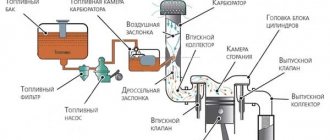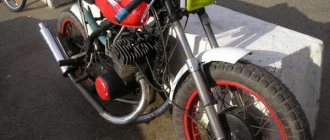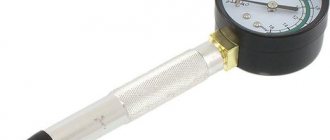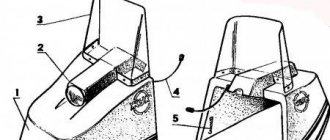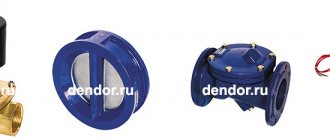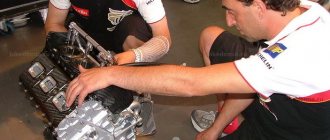Currently, two main types of internal combustion engines (ICEs) are actively used: two-stroke and four-stroke. In two-stroke engines, all operating cycles: intake of the finished fuel mixture, exhaust gas exhaust and purge, occur within one revolution crankshaft in two main steps. Engines of this type do not have timing valves; their role is played by a pair of piston and liner. As the piston moves, it closes the inlet, outlet and purge windows. Therefore, such engines are simpler in design and reliable, and under certain conditions, more powerful. Previously, there were two-stroke trucks, but they were crushed by environmental requirements.
Two-stroke diesels
Few people know that not so long ago there were two-stroke diesel engines with a dry sump, which were successfully operated in the USSR until the 90s. A distinctive feature of such a two-stroke engine was the presence of a gas distribution mechanism, which had only a pair (or one) exhaust valves, but the intake was carried out in the classical way for two strokes - through purge windows. Such engines include YaAZ-204 and YaAZ-206 [1], tank engines 5TDF (700 hp) and 6TDF-2 (1200 hp) [2]. Another attractive difference from its gasoline counterpart is that the diesel engine was purged with air, and not with a working mixture, as in the gasoline version, so the efficiency of the two-stroke diesel engine was comparable to the four-stroke version.
Engine drawings here
The power of a two-stroke engine with the same liter tank size and shaft speed is approximately 50-70% greater than a four-stroke engine due to the greater number of operating cycles per unit time. However, incomplete use of the piston stroke for expansion, poorer release of the cylinder from residual gases and the expenditure of part of the generated power on purging lead to an increase in power of only 60...70% compared to a four-stroke internal combustion engine.
Pros and cons of internal combustion engines
First, let's look at all the existing advantages and disadvantages of two-stroke engines, which, despite their design, are very popular. Their advantages include:
- Simplicity of design
- High speed of acceleration
- Low cost, which makes tools equipped with such units very popular
- Ease of maintenance due to the absence of a timing belt and a separate lubrication system
- Light weight and dimensions, which makes tools with such internal combustion engines convenient and practical
Now let's look at all the disadvantages that two-stroke engines have:
- Noisy operation
- Low environmental friendliness, which is due to the release of unburned fuel into the atmosphere
- Low work resource
- The need to mix gasoline with oil at every refueling. In addition, diluted fuel cannot be stored for a long time, otherwise it will spoil.
- High fuel consumption
- Low power compared to four-stroke
4-stroke units have many more advantages, however, disadvantages such as design complexity, heavy weight and price leave a negative imprint. Not everyone can afford to buy, for example, a snow blower with a 4-stroke engine, which costs 2 times more than an analogue with a more primitive unit. All the disadvantages of 2-stroke engines are the advantages of four-stroke engines.
Due to the large number of shortcomings of both types of engines, manufacturers have patented the production of modernized internal combustion engine models, which are called 4-MIX and 2-MIX. Surely you have encountered the fact that when repairing or replacing engine parts of a chainsaw or lawn mower, the presence of a timing mechanism was discovered, but the tool is filled with diluted gasoline and oil, as indicated by the manufacturer. That's right, this means that your instrument is equipped with a 4-mix motor. We will learn more about these types of engines below.
General summary of the engine
A two-stroke engine consists of a crankcase (its main part is the base), in which the crankshaft is mounted on ball bearings. The cylinder is attached to the block through screws or studs that pass through the entire body of the liner. A piston moves inside the cylinder - a metal cup (usually made of an aluminum alloy), surrounded by spring rings (piston rings) inserted into grooves on the piston below the hot zone. During compression or the power stroke, the piston rings do not allow gases to pass through and are locked in the space between the piston bottom and the cylinder walls. The piston is equipped with a metal rod - a pin; it connects the piston to the connecting rod. The connecting rod transmits the linear reciprocating motion of the piston into the rotational motion of the crankshaft.
All rubbing surfaces and bearings inside two-stroke engines are lubricated using a fuel mixture into which the required amount of oil is mixed. From the animation it is clear that the fuel mixture (blue color) enters both the crank chamber of the engine (this is the cavity where the crankshaft is fixed and rotates) and into the cylinder. There is no lubricant there anywhere, and even if there was, it would have been washed away by the fuel mixture. This is the reason why oil is added in a certain proportion to gasoline. The type of oil used is special, specifically for two-stroke engines. It must withstand high temperatures and, when burned together with the fuel, leave a minimum of ash deposits.
Lubrication system and fuel preparation
The operation of a two-stroke engine requires effective lubrication of moving parts. There is no centralized separate lubrication system with an oil pump, like in four-stroke engines, so oil is added to gasoline in a ratio of 1:25 - 1:50. The resulting composition, being in the piston and crank chambers, lubricates the connecting rod bearings, cylinder walls and piston rings. When the air mixture ignites, the oil burns and is removed along with the exhaust gases.
The motor oil must be special - for a two-stroke engine, usually it is marked 2T on the canister. The use of conventional automobile oil is unacceptable for a number of reasons:
- Oil for two-stroke engines must have good solubility in gasoline;
- Has excellent lubricating properties, improving engine performance and reducing friction;
- Protection against corrosion of rubbing parts of the piston group;
- Two-stroke oil should burn without residue, without forming soot or soot. The high ash content of conventional oil leads to coking of the piston rings.
Lubricant can be supplied to a two-stroke engine in two ways. The first and simplest is to mix it with fuel in the required proportion. The second is a separate lubrication system of a two-stroke engine, when a composition of fuel and oil is prepared immediately before entering the engine in a special pipe. In this case, a separate oil tank is installed, and its supply is carried out using a special plunger pump.
This system is widely used on modern motorcycles and scooters. In addition to ease of use (now you no longer need to add oil to the tank by eye every fill-up), serious oil savings occur because its injection depends on engine speed. At idle speed the oil proportion can be as low as 1:200.
Operating principle
Compression stroke.
The piston moves from bottom dead center (BDC) to top dead center (TDC), first closing the purge window and then the exhaust window. After the piston closes the exhaust window in the cylinder, compression of the combustible mixture that previously entered it begins. At the same time, in the crank chamber, due to its tightness, and after the piston closes the purge windows, a vacuum is created under the piston, under the influence of which a ready-made combustible mixture enters the crank chamber from the intake manifold through the inlet window and the slightly open valve.
Power stroke.
When the piston is positioned near TDC, the compressed working mixture is ignited by an electric spark from the spark plug, as a result of which the temperature and pressure of the gases increase sharply. Under the influence of thermal expansion of gases, the piston moves to BDC (while the expanding gases perform useful work). At the same time, going down, the piston creates excess pressure in the crank chamber. Under the influence of this pressure, the valve closes, thus preventing the combustible mixture from returning to the intake manifold and carburetor. When the piston reaches the exhaust window, it opens and the exhaust gases begin to be released into the atmosphere of our beloved Earth - the pressure in the cylinder decreases. With further movement, the piston opens the purge window and the combustible mixture compressed in the crank chamber flows through the channel, filling the cylinder and purging it of exhaust gas residues.
Thermal and dynamic calculation of internal combustion engines
Ignition principle. Since the fuel mixture takes time to ignite, the spark appears at the plug a little earlier than the piston reaches TDC. Ideally, the faster the piston moves, the earlier the ignition should be - the piston reaches TDC faster from the moment of spark. There are mechanical and electronic devices that change the ignition angle depending on engine speed. Almost for scooters before 2000. There were no such systems and the ignition timing was set statically for optimal speed.
What is an internal combustion engine on gas-powered tools?
An internal combustion engine is a unit that transforms fuel into mechanical energy. Today, internal combustion engines are used everywhere - from tools to cars and other types of equipment. The principle of operation of the internal combustion engine is due to the fact that a combustible mixture based on gasoline with air is supplied to the design. The carburetor is responsible for creating the desired consistency of the combustible mixture.
The combustible mixture is fed into the cylinder, where it is ignited. The combustion of the mixture creates useful energy that is removed from the crankshaft in the form of rotational movements. The main advantage of the internal combustion engine is that it has high power when compared with electric motors. Most gas-powered tools—trimmers, brush cutters, walk-behind tractors, chainsaws, etc.—are equipped with two-stroke internal combustion engines. More powerful petrol tools are equipped with a four-stroke internal combustion engine. What is the difference between two-stroke and four-stroke engines, what operating principle do they have, as well as their pros and cons are described in the material.
Repair of two-stroke internal combustion engines
Repair of two-stroke internal combustion engines is carried out only by qualified workers according to technological and route maps developed by engineers and designers. These instructions allow the worker to understand where and when to use this or that operation, how and in what order to install parts, as well as in what sequence and with force to tighten them.
The “two-stroke” machines themselves are installed in special tilting stands, which allow the correct assembly and pulling of its components to be carried out visually and conveniently.
The development of an internal combustion engine repair process includes not only a visual inspection and washing of the entire assembly in a washing machine, but also the development of parts defect maps, restoration route maps, etc.
This is exactly how repairs of two-stroke internal combustion engines are carried out in the production conditions of ATP.
Principle of operation
The main difference between 4-stroke and two-stroke engines is the design of their mechanisms for removing and supplying fuel to the cylinder. The 4-stroke unit is based on a special mechanism that opens and closes the exhaust and intake valves at a certain point in time. When we talk about a model with 2 working strokes, then the cleaning and filling of the cylinder with mixtures occurs simultaneously with the processes of compression and rarefaction. To do this, two working holes are made on the cylinder walls. One of them is purge, and the second is inlet.
Disadvantages of two-stroke engines:
1. Higher fuel consumption. Let us remind you that the approximate consumption can be calculated using the formula: for a two-stroke 300 grams per horsepower, for a four-stroke 200 grams. 2. Noisy. At maximum speed, two-stroke engines tend to be slightly louder than four-stroke engines. 3. Comfort. Four-stroke internal combustion engines do not vibrate as much at low speeds (applies only to two-cylinder engines - single-cylinder two-stroke and four-stroke engines vibrate approximately the same) and do not smoke as much as two-stroke engines. 4. Durability. Quite a controversial point. There is an opinion that two-stroke engines are less durable. On the one hand, this is understandable, because the oil for lubricating the rubbing elements of the engine is supplied along with gasoline, which means it does not work as efficiently as in four-stroke engines where the rubbing elements literally float in oil. But on the other hand, a four-stroke engine is much more complex in design than its competitor, consists of a much larger number of parts, and the golden principle of mechanics “The simpler the more reliable” has not yet been canceled. 5. High temperature and overheating of individual parts, due to more frequent flash of the working mixture in the cylinders. More intensive cooling is required. 6. Increased air consumption (double), which leads to rapid failure of the air purification system filters. The T-64 and T-80UD (T-84) tanks had this problem.
Operation and causes of engine failure
Most often, two-stroke engines are found in motorcycles, boat engines, lawn mowers, chain saws and other devices that require the use of a lightweight and reliable engine. However, even such a simple engine can fail due to violation of operating rules.
- Low quality gasoline. Bad fuel often leads to detonation. Most often this is noticeable at low speeds when accelerating. The resulting shock loads lead to breakage of the piston partitions and excessive loads on the crankshaft bearings. Detonation can occur due to engine overheating, carbon deposits on the piston and a lean mixture.
- Low quality of parts from which the motor is assembled. This is especially true for Chinese manufacturers, who often allow defects in the production of components. This leads to early failure of the piston, crankshaft, cylinder and other parts, and then to major repairs. A simple compression test usually helps to assess the condition of the piston.
- Low quality motor oil. The fuel/oil mixture for two-stroke engines is very important. It is its quality that will determine how smoothly the engine operates, the cleanliness of the exhaust, the absence of overheating and unnecessary noise. Bad oil leads to the formation of a layer of carbon on the piston, in the main and connecting rod bearings, to scuffing on the cylinder walls and piston skirt, and the flow area of the muffler is reduced due to carbon deposits. Oils for two-stroke engines should be used synthetic or semi-synthetic; the use of mineral water is undesirable.
- Overheating on a two-stroke air-cooled engine is not uncommon. This is caused by prolonged operation with the throttle fully open, or a malfunction of the cooling system. Overheating can be short-term, when there is a loss of power and maximum speed; after reducing the load and cooling the engine, everything returns to normal. The wedge occurs as a result of very strong overheating, when the thermal gap between the piston and cylinder decreases so much that friction forces tightly grab them together. After this, repair of the CPG is required.
- The carburetor is not adjusted. The fuel mixture is too lean or too rich. Driving with an over-enriched mixture is fraught with high fuel consumption, loss of power and the formation of carbon deposits. A lean mixture can cause detonation and reduce maximum engine power.
To extend the service life and delay major repairs, you should properly break in a two-stroke boat or motorcycle engine. To do this, the proportion of oil mixed with gasoline should be slightly higher than that established for normal operation. With this mixture, let the engine run at partial power for several hours, which is equivalent to 500-1000 km for a scooter and motorcycle.
Nevertheless, due to exhaust toxicity, two-stroke engines are gradually being replaced by modern four-stroke engines. They continue to be used only where high power density is required with minimal weight and simplicity of design - motor vehicles, chainsaws and trimmers, model airplanes and much more.
If you have any questions, leave them in the comments below the article. We or our visitors will be happy to answer them
How to increase cravings
The thrust of two-stroke engines depends on the opening of the throttle valve. With a sharp increase in engine speed, traction increases. It follows that in order to reduce the acceleration time of the internal combustion engine, it is necessary to increase the working volume of the cylinder.
When the engine operates at low speeds, high-quality traction increases throttle response and increases acceleration.
Thrust can also be increased by replacing the valves with special ones and adjusting them so that they stay open longer than regular ones.
How to increase power
Like 4-stroke engines, 2-stroke engines can be improved, so-called chip tuning.
To increase the power of the internal combustion engine, you can do the following:
- Bore the exhaust hole so that the exhaust gases escape completely.
- Improve the blowing effect. Purging is the removal of exhaust gases and filling the working volume of the cylinder with a new portion of the fuel mixture. It must be done so that fuel can be injected into the combustion chamber through the inlet window. If fuel does not enter the combustion chamber in the required volume, fuel will accumulate in the engine crankcase. Therefore, for high-quality filling of the working part of the cylinder with fuel, it is necessary to increase the diameter of the exhaust window opening (exhaust gas emission).
- You can use a swirl diffuser on a carburetor. A swirl diffuser is also called a zero diffuser. Due to this diffuser, more fuel will enter the cylinder in a shorter period of time.
- Mount a special resonator on the muffler, suitable for the speed of the specific engine. The resonator makes sure that the unburned fuel mixture returns back to the cylinders. This is effective when incomplete combustion of the mixture occurs in the cylinder.
In order for the part of the cylinder under the piston to be filled completely, it is necessary to inspect the inlet and outlet channels; perhaps there are scratches, burrs, or chips on the holes. Such small defects affect the speed of movement of fuel and gases.
For a better effect of increasing power, the cylinder head (cylinder head) can be milled and then ground.
It is not recommended to reduce the weight of engine parts, since due to an increase in the difference in the counterweight and a violation of the center of gravity, the end runout of the flywheel and crankshaft may increase.
How does he work
Let's consider the principle of operation. The full operating cycle in a two-stroke internal combustion engine occurs in two strokes:
Bar one
Compression. The piston moves from the bottom dead center position to the top position, while first closing the purge window and then the exhaust window. After this, the fuel mixture that entered it earlier is compressed in the cylinder. At the same time, a discharged space is created in the crank chamber under the piston, after closing the purge window. Under the influence of this vacuum, a combustible mixture enters the crank chamber from the carburetor through the inlet window.
Measure two
Working progress. When the piston is set at its highest point, the compressed fuel mixture is ignited by an electric discharge from the spark plug, causing the pressure and temperature of the gases to increase sharply. Under the influence of this expansion, the piston moves to the bottom dead center position - the expanded gas performs useful work. At the same time, going down, it creates a lot of pressure in the crank chamber, closing the valve. Once the valve is closed, gases cannot re-enter the intake manifold and carburetor.
When the piston reaches the exhaust window, it opens and exhaust gases begin to be released, their pressure in the cylinder decreases. Moving further, the piston opens the purge window, and the compressed combustible gases in the crank chamber pass through the channel into the cylinder, purging it of the remaining gases. After this, the cycle repeats again. » alt=»»>
Purge problem
The higher the crankshaft speed, the more power. But the design of two-stroke engines has this peculiarity - the faster the piston begins to move, the worse the combustion chamber of the cylinder is purged, since the exhaust gas supply and exhaust windows remain open for a very short time.
Chamber purging is the removal of gases and injection of fuel into the cylinder from the crankcase. Fuel begins to be sucked in and remain in the crankcase as the piston moves upward. Then, when the piston goes down, the inlet port closes and the purge window opens, through which a new portion of fuel is supplied and the gases of the previous spent fuel mixture are expelled (see the figure above, in the middle).
This simple design of a two-stroke engine eliminates the need to install a gas distribution mechanism (GRM), a purge pump, valves and a lubrication unit.
Purging while a two-stroke engine is idling (idling) is carried out differently. During operation at XX, purging is carried out by opening the damper to a small angle. This kind of purging is not of high quality, so at idle speed, as many have probably noticed, the engine of a chainsaw or lawn mower does not work stably. As for a chainsaw, for example, Echo (Echo), then you need to pull the choke halfway.
A single-cylinder two-stroke engine has a contour blower, that is, a slot blower. At the bottom of the cylinder in the wall there is a special slot through which gas distribution occurs. During the compression and power strokes, that is, when the piston is up, the intake and purge ports must be closed.
Contour purge - this pre-piston volume (cylinder under the piston) is a purge pump. This design makes it possible to make engines of the smallest dimensions.
Lubrication
Lubrication in both models is also carried out differently. In our case, it is carried out by proportionally mixing gasoline and oil. A 4-stroke engine requires the use of a special expansion tank. it is connected by a system of pipes to a plunger pump. from here the lubricant falls into the inlet pipe. Moreover, its quantity is supplied exactly in the volume that is needed.
Based on the foregoing, we can highlight the following advantages that a two-stroke engine has:
- Greater power with the same displacement;
- Simple device;
- Light weight of the unit.
All this forces designers and developers of modern technology to use this model in their new projects. Who knows, maybe over time the discharge and compression system will undergo changes, bringing the efficiency of the equipment to a new level.
Features and advantages of two-stroke
Theoretically, the power of an engine of this type, with the same cylinder dimensions and shaft rotation speed, is twice as high as that of a 4-stroke engine due to the increased number of operating cycles. But due to the incomplete use of the piston stroke during expansion, the worse release of the cylinder from exhaust gases and partial power consumption for purging lead to an increase in engine power by only 60-70 percent.





